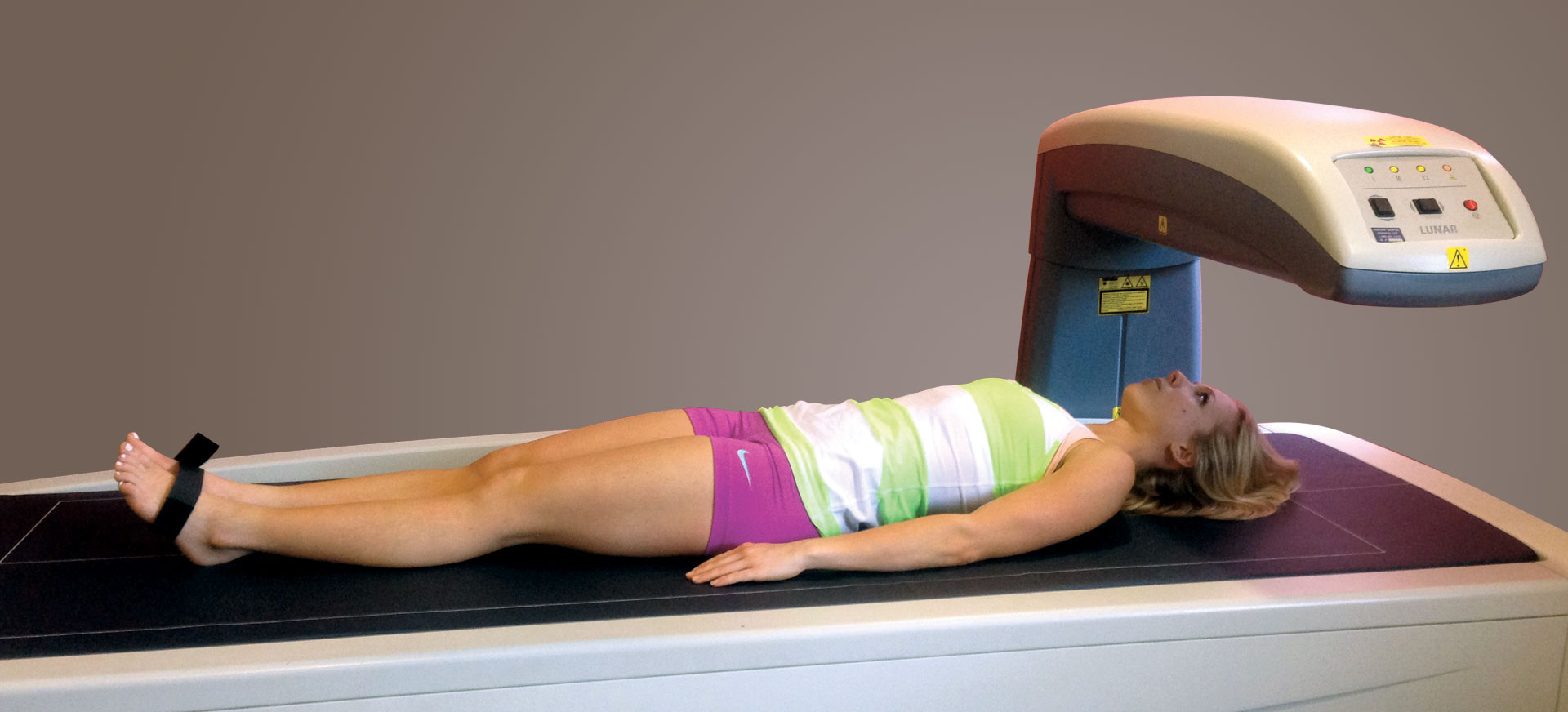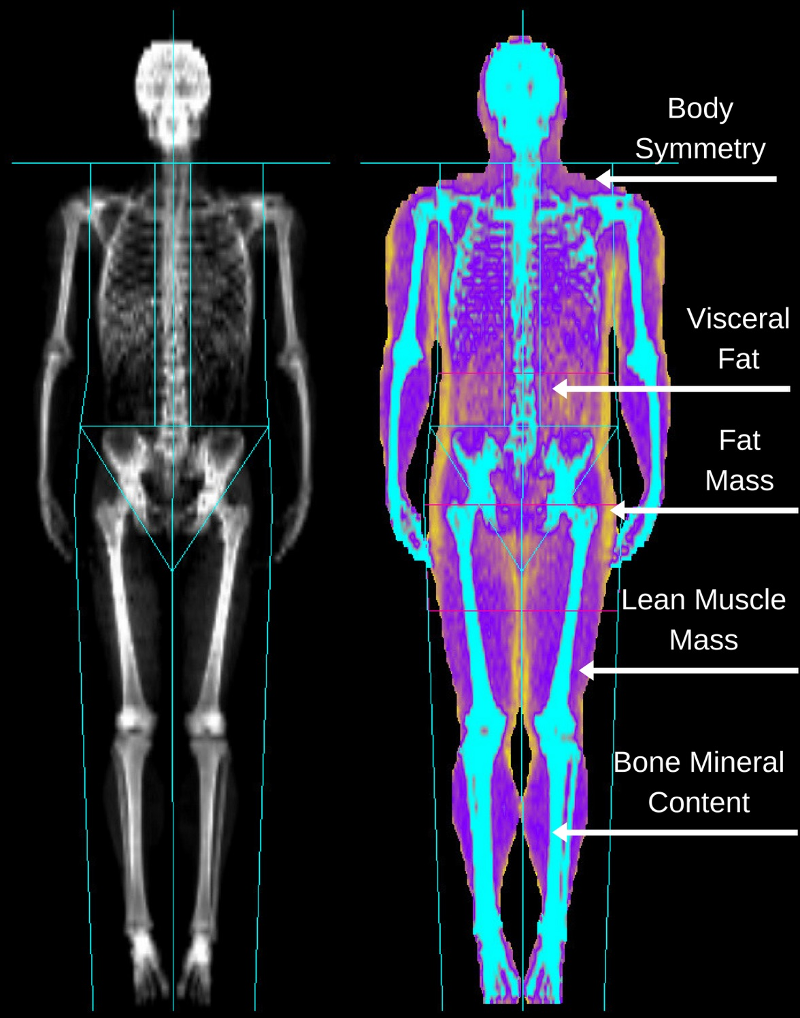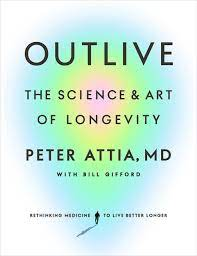855 Broadview Avenue,
Suite 305, Toronto, ON M4K 3Z1
Menu
Suite 305, Toronto, ON M4K 3Z1
Know your body’s blueprint of Fat, Muscle & Bone with a Reliable Dexa Scan near you.
What gets measured gets managed!
DEXA or Dual Energy X-Ray Absorptiometry is a safe, painless and scientifically developed imaging technology. It is the gold standard in measuring body composition. The DEXA Body Composition Scan is considered one of the most accurate and reliable methods of body composition analysis, with minimal radiation exposure and no discomfort to the patient.
The Bone Wellness Centre Toronto offers the Dexa Scan for measuring body fat and total body composition analysis. Our Dexascan technology can provide a detailed analysis of your body composition by measuring the amount of fat, muscle and bone in your body. During the Dexa Scan, you will lie on a table while a scanner arm passes over your body.
DEXA scans can be a powerful motivational tool for people tracking weight loss, nutrition, exercise, rehabilitation, longevity & overall health.

Looking to measure your body fat accurately? Look no further than Bone Wellness Centre, Toronto, and our cutting-edge DEXA Scan technology. Our DEXA Body Fat Scan is a state-of-the-art solution for measuring and tracking body fat levels. Using dual-energy X-ray absorptiometry (DEXA) technology, our scans provide a detailed analysis of your body fat percentage and the distribution of fat, muscle and bone.
At Bone Wellness Centre Toronto, we use DEXA Body Composition Scan to comprehensively analyze body composition, which can help develop personalized fitness and nutrition plans. The scan can also be used to monitor changes in body composition over time, making it an excellent tool for tracking progress toward weight loss or fitness goals. But why is measuring your body fat so important? After age 20, we all start losing muscle and gaining fat. You can’t tell through scale measurements or by looking in the mirror how much body fat you have. A healthy body fat percentage is essential for maintaining good overall health, as carrying too much fat can increase your risk of various health issues. The DEXA Body Composition Scan can also provide important information about body fat, which is crucial to prevent obesity-related issues and reduce the risks of heart disease, diabetes, high blood pressure, high cholesterol and cancer.
By tracking your body fat levels accurately, you can make informed decisions about your diet and exercise routine and take the necessary steps to improve your overall health.
At Bone Wellness Centre, we are committed to providing our clients with the highest care and expertise. At our centre, DEXA Scan Body Fat is performed by experienced professionals who will guide you through the process and provide you with a detailed report of your body composition results. With our advanced technology, you can trust that your results will be accurate and reliable.
Overall, the DEXA Body Composition Scan is a valuable tool for anyone interested in improving their health and fitness and for healthcare providers seeking to diagnose and treat various medical conditions.
So why wait? Schedule your DEXA Body Fat Scan now!
Take the first step towards a healthier, happier you by booking your DEXA Body Composition scan today!


Dr. Peter Attia is a well-known physician who advocates for using advanced medical technology to help people optimize their health and longevity. One of the tools he often recommends is dual-energy X-ray absorptiometry (DEXA) scans. Dr. Attia is a strong proponent of using annual DEXA scans to track progress and optimize health. He has spoken about the benefits of DEXA scans in this video.
The Netflix Documentary “You Are What You Eat” emphasizes how the DEXA Scan is a groundbreaking tool in measuring body composition & it is the best investment in your overall health. It gives a true picture of your fat mass, lean tissue, visceral fat & total bone density. Excess body fat is associated with many health risks. Focus on getting healthy to enhance your quality of life. Book Your DEXA scan today! What gets measured gets managed!
This test measures one’s body fat & gives a 3-dimensional measurement of: Fat Tissue Mass (Subcutaneous Fat & Internal Visceral Fat), Lean Muscle Mass and Total Body Mineral Content (Total Skeletal Mass & Bone Density)
It is safe, simple, & painless.
At The Bone Wellness Centre, the DEXA scan typically takes between 6 to 12 minutes to complete. During this time, you will be asked to lie on a flat table while a scanner arm moves over your body to capture images. You will be with us for 30 minutes in duration. This includes the scan, analysis, immediate results and discussion of your data.
DEXA uses a 3-Dimensional model to measure body fat. It divides the body into fat tissue mass (subcutaneous fat & internal visceral fat), lean muscle mass, and total body mineral content (total skeletal mass & bone density). The total body scan shows the skeleton & soft tissue. It directly measures the percent body fat for the entire body and sub-regions. It can show the muscle, fat & bone in grams for the entire body and per the arms, legs & trunk. The total body composition test looks at fat distribution using the android (waist) to gynoid (hip) ratio. Carrying too much fat in the wrong areas can increase your chance of serious health problems.
Men with a waist-to-hip ratio of > 1 & women with a ratio > 0.8 have an increased risk of cardiovascular illness. An apple-shaped body (excess fat around the abdomen, trunk, and inside the abdominal cavity) can increase one’s risk for diabetes & heart disease. Pear-shaped body types (excess fat around hips, thigh & buttocks) are less prone to harmful illness. This accurate & precise technique actually shows how much fat you are losing. Total Body Composition Scans provide far more complete and precise information to help support diagnoses, guide treatment, and even help athletes decide on the training regimens they use to achieve the best performance.
DEXA boasts accuracy, reproducibility, safety, speed and simplicity. No other technique can match the results obtained from DEXA. Measurements of body composition help show how lean mass and body fat change during health and disease.
Skin callipers: Measures only fat under the skin, high likelihood of technical error, not good for lean or obese people
Bioelectrical impedance analysis (BIA): High rate of false positive and false negative results, too many variables to control
Underwater Weighting: Being submerged in water requires heavy equipment and is time-consuming
Bod Pod: Only a two-dimensional reading based on air displacement, not readily available, very expensive
CT: Very high dose of radiation and expensive, not readily available for body fat measurement
MRI: Extremely expensive, not readily available for body fat measurement
Body weight alone is not a clear indicator of good health because it does not distinguish how many pounds are fat and how many are lean body mass. It is not the amount of weight measured but the amount of fat in the body that is potentially dangerous to health. Excessive body fat is a serious health risk & can increase one’s risk for diabetes, heart disease, cholesterol, hypertension, gout, joint disease, musculoskeletal problems, cancer, gall bladder disease, sleep apnea & respiratory distress. Inadequate body fat can lead to malnutrition, osteoporosis, or anorexia. The body needs a certain amount of fat to regulate our body temperature, insulate our internal organs and provide our body’s energy storage.
On the day of your Scan:
Normal Fluid Intake – you may have about 3 glasses (You may have your tea, coffee, juice); please don’t over hydrate
Please kindly email us for pricing.
You will have to contact your insurance provider regarding coverage. If you have a healthcare spending account, the cost may be reimbursed.
DEXA Scans are extremely low in exposure, less than a flight from Toronto to Vancouver and less than natural background radiation for the day!
Radiation Effective dose (uSv)
Government of Canada – Radiation Doses
Radiation Dose Examples (Source: Canadian Nuclear Safety Commission)
Radiation levels are measured in: 1mSv (millisieverts) = 1,000μSv (microsieverts)
Study | Dose (μSv) | Dose (mSv) |
DEXA body composition on Prodigy Advance | 0.5-1.0 μSv | 0.0005-0.0010 mSv |
Cross Country Canada Flight | 20μSv | 0.02mSv |
Chest x-ray | 100μSv | 0.1mSv |
Screening Mammography | 3000μSv | 3mSv |
Chest CT Scan | 7000 μSv | 7mSv |
Natural Background Radiation in Canada – Average Annual Dose | 1800μSv | 1.8 mSv |
Natural Background Radiation in Canada – Average Per Day | 4.93μSv | 0.00493mSv |
Metal inside the body will be added as bone and will be consistent from scan to scan and comparative results will be valid.
Implants will lean out DEXA measurements; they will decrease the body fat. If the implant is filled with silicone, the body fat will be impacted more than if the filler material is saline. As long as the implants remain in the body, the results can be compared. If the implants are removed, a new baseline scan would be required.
It is best to have normal hydration levels for the scan. Water is not fat or bone mineral content and is thus added to lean tissue. If one is extremely dehydrated or fasting for long periods prior to the scan, then this can reduce the total lean tissue values. If one is extremely hydrated, then this can increase the lean tissue values.
No, our in house physician does the prescribing for the scan.
DEXA scans use a very low level of x-ray consisting of two different beams. One is a higher energy beam, while the other is a lower intensity. The lower intensity beam is only absorbed by soft tissue (muscle and fat), where as the higher intensity beam gets absorbed both by bones and by soft tissue. These differences in absorption are used to determine bone mineral density (BMD) and body composition values.
The following DEXA sample scans depict how muscle mass, body fat, and bone density are highlighted and compared. See how these factors play out for obese individuals compared to athletes and bodybuilders. By clearly representing your body fat and muscle composition, you can make serious steps to improve your health, fitness level, and diet accordingly.
A unique health facility that uses state-of-the-art DEXA technology to perform comprehensive total body composition studies to measure one’s body fat & determine cardiovascular health risks & obesity.
Our mission is to increase our patient’s overall quality of life with early detection and patient awareness of the disease. Using the science of DEXA, we help one obtain a benchmark for one’s health, body, fitness & nutrition. Through clarity, measured results, accountability & motivation, we want our patients to be proactive in their journey of health & well-being.
855 Broadview Avenue, Suite 305, Toronto, ON M4K 3Z1
By appointment only
DEXA SCAN: Know your body’s exact blueprint of fat, muscle & bone. This gold standard measurement instills the reality check to evaluate your true measured results. What gets measured gets managed!
Copyright © 2023 The Bone Wellness Centre. All Rights Reserved. Disclaimer | Terms | Privacy Policy | Blog